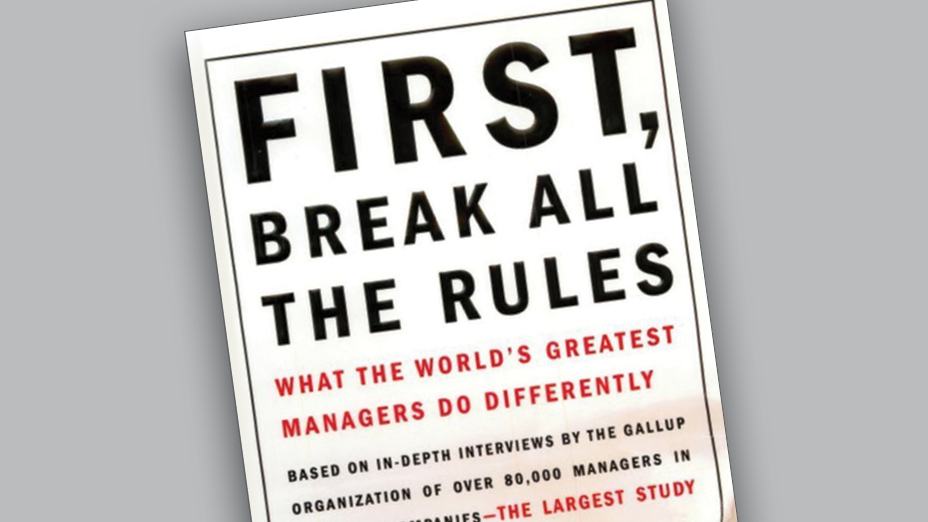This book is a result of an exhaustive study undertaken by the Gallup organization involving 80,000 managers across a large number of industries exploring the concepts of employee satisfaction, selecting and maintaining good employees, and means of measuring employee satisfaction. The approach was revolutionary when published (1999) and has become a business classic because it challenged the status quo. First Break All the Rules asserts that the status quo is counterproductive and encourages management to adopt innovative approaches to employee engagement. There are four keys for unlocking potential in your employees: select for talents, suggest outcomes rather than direct control of process, focus on employees’ strengths and work around weaknesses, and finally find the right fit for your employees.
The Big Idea: Measuring Stick
If you are in business, it is paramount to know how you are performing relative to your competition through the eyes of your employees. With rigorous research and data analysis Gallup isolated 12 questions that strongly reflect a company’s success:
1. Do I know what is expected of me at work?
2. Do I have the equipment and material I need to do my work right?
3. At work, do I have the opportunity to do what I do best every day?
4. In the last seven days, have I received recognition or praise for good work?
5. Does my supervisor or someone at work seem to care about me as a person?
6. Is there someone at work who encourages my development?
7. At work, do my opinions seem to count?
8. Does the mission/purpose of my company make me feel my work is important?
9. Are my co-workers committed to doing quality work?
10. Do I have a best friend at work?
11. In the last six months, have I talked to someone about my progress?
12. This last year, have I had opportunities at work to learn and grow?
As a manager it is your responsibility that your employees reply with an emphatic “yes” to these questions. Positive responses to these questions were strongly correlated to profitability, productivity, employee retention, and customer satisfaction. If you can generate positive responses to these questions, then you have the ability to attract and retain quality employees. The importance of influential perks, pay, or a charismatic CEO were not established in the author’s research.
Insight #1: Identifying and Understanding Talent
Great managers know that every role in a workplace requires talent because there are recurring patterns of thoughts, feelings, and behaviours. Managers that are able to select for these patterns will have more harmonious results on their team. One of the biggest mistake managers make is selecting for other factors like experience or intelligence, and ignore required talents (for example, empathy is a required trait for nurses). In my own experience, the results of applying this concept have been profound. However, it can be difficult to define and explain the concept of talent to others. Buckingham and Coffman have divided talents into three basic categories: striving talents, thinking talents and relating talents.
STRIVING TALENTS explain the ‘why’ of a person: what motivates them, do they want to stand out, and is ‘good enough,’ good enough for them?
THINKING TALENTS explain the ‘how’ of a person: how they think, their decision-making processes, are they focused, disciplined, strategic or non-linear in thinking?
RELATING TALENTS the ‘who’ of a person: who do they trust, who they build relationships with, do they avoid confrontation or have a desire to win people over? Do they love or hate surprises?
We all possess talents within the contexts of these categories. It is important to recognize that talents can’t be taught, they can only be cultivated and encouraged within the work roles assigned to that person. Skills, on the other hand, can be taught (i.e. typing speed, surgical techniques, software etc.). This does not mean entirely that people can’t change over time, but as managers we need to be aware of underlying talents and work with them rather than against them. As Tom Rath says, “the key to human development is building on who you already are.”
Insight #2: Temptations to Avoid
High performing managers understand that trying to achieve direct control of employees is futile, and that trying to change people’s natural talents will not work. The solution is both simple and elegant: define a required outcome and then let the employee find their own way forward, through a path of least resistance.
This can be difficult as managers may believe that certain processes achieve results, and it’s tempting to stick with what’s worked in the past. The authors identified four temptations that lead managers away from adhering to setting expectations.
• Creating “perfect people” by imposing a “best way” attitude and that you have the right answers. This is disempowering, demeaning and prevents self-exploration and learning.
• Believing that employees don’t have enough talent, which can be true, but not if your hiring criteria is critically based on talents rather than selecting for other strengths.
“The most efficient way to turn someone’s talents into performance is to help him find his own path of least resistance towards the desired outcome.”
• Believing that “trust is precious—it must be earned.” Great managers must reject the concept of earning trust: if you expect the best from your team you will often get the best.
• Believing that “some outcomes defy definition” such as abstracts like employee satisfaction and customer feedback.
Buckingham and Coffman suggest breaking these principles down into emotional statements and using them as expectations. Try using and rating the first six questions for employee engagement (outlined above) and define what positive emotions you hope to see in relation to your clients. “I want our customers to feel respected and cared for,” is a value driven statement that will guide the emotional direction of your team. This is a business book that has stood the test of time and is highly recommended to any management team interested in achieving better results.




.png)


%20(1).png)
What Did You Think?